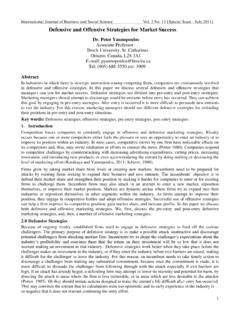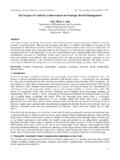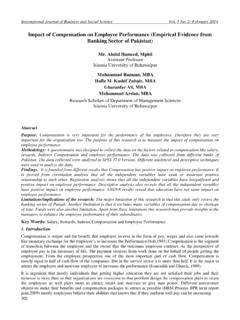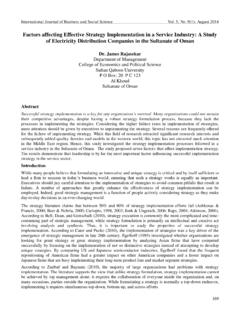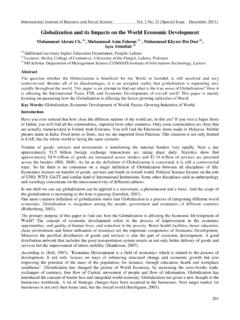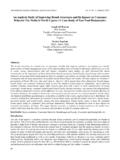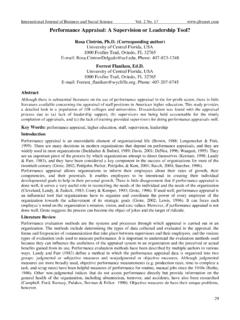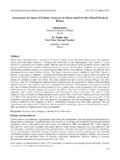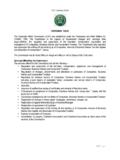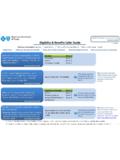Transcription of The Impact of Customer Loyalty Programs on …
1 International Journal of Business and Social Science Vol. 6, No. 8(1); August 2015. The Impact of Customer Loyalty Programs on Customer retention Dr. Sima Ghaleb Magatef Dr. Elham Fakhri Tomalieh Marketing Assistant Professor Marketing Department Faculty of Administrative and Financial Sciences University of Petra Amman 11196. Jordan Abstract The goal of this study is to obtain a deep understanding of the Impact of Customer Loyalty Programs on Customer retention . This study was applied to Jordanian customers. The study investigates the Impact of independent variable; Loyalty Programs : point system, tier system reward, charges an upfront fee for VIP benefits and non- monetary Programs , on the dependent variable: Customer retention .
2 To achieve the objective of the study, a survey was conducted to collect data from the sample. In total (350) questionnaires were distributed randomly to Jordanian customers who could be reached by the researchers, and were contacted through friends, relatives, students and local malls. The participants had different social, educational, and occupational backgrounds. Response rate was ( ) Percent. The findings clearly show: there is significant evidence of the effect of all Loyalty Programs on building and maintaining Customer retention . The major effect was for Tier system reward followed by charge Up-front fee for VIP benefits, and then point system, the weakest effect was for Non-monetary Programs .
3 Keywords: Loyalty Programs : point system, tier system reward, charges an upfront fee for VIP benefits, non- monetary Programs , Customer retention 1. Introduction The use of Loyalty Programs as a powerful tool of relationship marketing is becoming popular to encourage Customer Loyalty . (Roking 2005). The use of Loyalty Programs can introduce benefits to both customers and companies. Customer Loyalty is an important issue for the success of any retail organization, because it is known that drawing new customers is more expensive than keeping existing ones. (Singh & Imran 2012) Singh & Imran (2012) estimate that on average online retailers lose 25% of their customers every year, and a small increase in Customer retention can increase profits by more than 25%.
4 Relationship marketing aims to create life time customers because when customers have a relationship with a company, they are ready to forget any other competitors offer. Customers are motivated to do that because it gives them a greater efficiency in decision making, reduces the information processing, achieves a greater cognitive consistency in decisions, and reduces the perceived risks associated with future decisions. (Singh & Imran 2012) To build loyal customers companies use several types of Loyalty Programs . 57% of airlines and 41% of hotel chains reward consumers for a range of engagement behaviors. A typical approach uses Platinum, Gold and Silver tiers, typically based on purchase volumes.
5 (Shaw Ray, 2015) In spite of the fact that the average US household has over 21 Loyalty program memberships, fewer than half of these are active. Key reasons for that are Loyalty Programs include lack of reward relevance, rigid reward structures, and poor quality Customer service. More than half of consumers admitted that they had abandoned at least one Loyalty program according to a survey and social media scanning by Consulting Date. However, Loyalty Programs need to be designed with more targeted rewards, differ according to different groups of members based on their value, and they need to provide greater value at higher Customer value tiers, by rewarding best customers to encourage higher spending levels.
6 In order to do that the organization needs to understand their Customer 's needs and behaviors, by creating Customer profiles with relevant data on Customer interactions to have a complete picture of a Customer 's preferences. (Ray Shaw, 2015). 78. ISSN 2219-1933 (Print), 2219-6021 (Online) Center for Promoting Ideas, USA 2. Theoretical Frame Work Customer retention According to kotler The key to Customer retention is Customer satisfaction . Customer retention means the company keeps its customers by providing a great Customer experience. Customer retention is the key to healthy business growth. Loyalty can help the business to retain most valuable customers.
7 Loyalty reflects relationship development and retention reflects relationship continuity. Customer retention is a crucial component of Customer relationship. The main aspect of Customer retention is the emotions evoked by the Customer experience combined with the organization's strong reputation. Without the emotional bond which is essential to retain customers, Customer Loyalty will be impossible. Customer retention is important to most companies because the cost of acquiring a new Customer is greater than the cost of maintaining a relationship with a current Customer . (Singh & Imran 2012) retention Programs aim to turn the occasional Customer into a frequent Customer ; they would be more likely to recommend the business to their friends and relatives.
8 They also raise the probability of changing customers from being a one or two item purchaser to purchasing several products. ( Rocking, 2005) Because the high cost of losing customers is rising every day, companies seek new techniques to acquire, and retain their loyal customers. Service has long been an important factor in Customer retention , and new research suggests its role is more critical than ever and will continue to grow in the future. (Potter -Brotman Jennifer, 1994). Customer retention earns the business a good reputation and goodwill in a competitive market. (Singh, & Khan, 2012). Customer retention is all about the customers and their experience.
9 Customer relationship management is the practice of analyzing and using marketing and leveraging communication technologies to determine corporate practices and methods that maximize the life time value of each Customer to the firm (Reinartz, 2004). The fact that Customer retention is widely accepted as it is central objectives in relationship marketing. Because Customer retention focuses on repeated patronage of a marketer or supplier, it is closely related to repeat purchasing. (Hennig & klee, 1997). Loyalty Customer Loyalty is the Customer attitude and behavior to prefer one brand over all competitor ones, whether? due to satisfaction with the product or services.
10 It encourages consumers to shop more consistently. (Peiguss, 2012). Customer Loyalty is defined as the willingness of any given Customer to purchase the company's goods or services over competitive ones available in the marketplace. (Singh, Khan, 2012). Due to the fact that Loyalty is the result of developing past positive experiences with the customers and having them return to the company various times due to these experiences, customers will return again and again to do business with the company; regardless of whether it may not have the best product, price or service delivery (Ghavami & Olyaei, 2006). Zikmund, (2002) demonstrate that Loyalty is more than a repetition of behavior.
